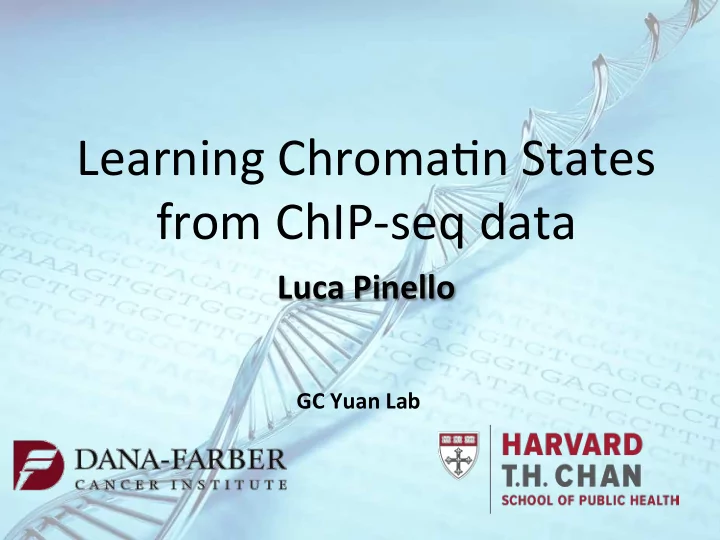

Learning ¡Chroma-n ¡States ¡ from ¡ChIP-‑seq ¡data ¡ Luca ¡Pinello ¡ ¡ ¡GC ¡Yuan ¡Lab ¡
Outline ¡ • Chroma-n ¡structure, ¡histone ¡modifica-ons ¡and ¡ combinatorial ¡pa?erns ¡ • How ¡to ¡segment ¡the ¡genome ¡in ¡chroma-n ¡states ¡ • How ¡to ¡use ¡ChromHMM ¡step ¡by ¡step ¡ • Further ¡references ¡ 2 ¡
Epigene-cs ¡and ¡chroma-n ¡structure ¡ • All ¡(almost) ¡the ¡cells ¡of ¡our ¡body ¡share ¡the ¡same ¡genome ¡ ¡but ¡ have ¡very ¡different ¡gene ¡expression ¡programs…. ¡ 3 ¡ h?p://jpkc.scu.edu.cn/ywwy/zbsw(E)/edetail12.htm ¡
The ¡code ¡over ¡the ¡code ¡ • The ¡ chroma-n ¡ structure ¡ and ¡ the ¡ accessibility ¡ are ¡mainly ¡controlled ¡by: ¡ ¡ 1. Nucleosome ¡ posi-oning, ¡ ¡ 2. DNA ¡methyla-on, ¡ 3. Histone ¡ modifica-ons. ¡ 4 ¡
Histone ¡Modifica-ons ¡ Specific ¡histone ¡modifica-ons ¡or ¡combina-ons ¡of ¡ modifica-ons ¡confer ¡unique ¡biological ¡func-ons ¡to ¡ the ¡region ¡of ¡the ¡genome ¡associated ¡with ¡them: ¡ • H3K4me3: ¡ promoters, ¡gene ¡ac.va.on ¡ • H3K27me3: ¡ promoters, ¡poised ¡enhancers, ¡ gene ¡silencing ¡ • H2AZ: ¡ promoters ¡ • H3K4me1: ¡ enhancers ¡ • H3K36me3: ¡ transcribed ¡regions ¡ • H3K9me3: ¡ gene ¡silencing ¡ • H3k27ac: ¡ ac.ve ¡enhancers ¡ 5 ¡
�������������������������������������������������������� ChIP-‑seq ¡to ¡measure ¡histone ¡data ¡ Measuring the regulome (e.g., protein-binding of the genome) Chromatin genomic Immunopreciptation intervals (ChIP) + peak caller Protein - bound by fragmentation bound DNA proteins DNA reads fragments a ChIP–chip ChIP–seq ChIP–seq input DNA Pros35 CG4908 eEF1 � NPC1 CG5708 CG5694 10,220,000 10,225,000 10,230,000 6 ¡ Adapted ¡from ¡Dewey ¡lecture ¡and ¡Peter ¡Park ¡Nature ¡Gene-cs ¡Review ¡
We ¡can ¡“call ¡peaks” ¡but… ¡ chr6:30,614,231-31,337,674 , , , , H2AK5ac H2BK5ac H2BK12ac H2BK15ac H2BK20ac H2BK120ac H3K4ac H3K9ac H3K14ac Histone H3K18ac acetylation H3K23ac H3K27ac H3K56ac H4K5ac H4K91ac H3K4me1 H3K4me2 H3K4me3 Histone H3K27me3 methylation H3K9me3 H3K36me3 H4K20me1 H3K79me1 H3K79me2 mCG/CG RNA (+) RNA (-) PPP1R10 DHX16 MDC1 IER3 DDR1 SFTA2 MUC21 HCG22 C6orf15 TCF19 HCG27 PRR3 MRPS18B PPP1R18 TUBB DDR1 DPCR1 MUC22 PSORS1C1 ABCF1 ATAT1 NRM FLOT1 CDSN TCF19 MIR4640 PSORS1C2 MIR877 C6orf136 NRM GTF2H4 PPP1R10 DHX16 VARS2 CCHCR1 C6orf136 NRM POU5F1 POU5F1 PPP1R18 ¡ Idea: ¡We ¡need ¡a ¡way ¡to ¡summarize ¡the ¡combinatorial ¡pa?erns ¡of ¡ mul-ple ¡histone ¡marks ¡ 7 ¡
ChromHMM ¡ “ChromHMM ¡is ¡a ¡Java ¡program ¡for ¡the ¡learning ¡ and ¡analysis ¡chroma-n ¡states ¡using ¡a ¡ mul-variate ¡Hidden ¡Markov ¡Model ¡that ¡ explicitly ¡models ¡the ¡observed ¡combina-on ¡of ¡ marks” ¡ h1p://compbio.mit.edu/ChromHMM/ ¡ 8 ¡
ChromHMM ¡and ¡ ¡Chroma-n ¡States ¡ • Chroma<n ¡states ¡ are ¡defined ¡based ¡on ¡different ¡combina-ons ¡of ¡ histone ¡modifica-ons ¡and ¡correspond ¡to ¡different ¡func-onal ¡ regions ¡ • The ¡goal ¡is ¡to ¡segment ¡the ¡genome ¡into ¡biologically ¡meaningful ¡ units. ¡ 9 ¡
ChromHMM ¡and ¡segmenta-on ¡ 10 ¡
ChromHMM ¡in ¡prac-ce: ¡gather ¡the ¡ ingredients ¡ • Required: ¡ 1. Java ¡virtual ¡machine ¡(h?p://java.com/) ¡ 2. ChromHMM ¡sohware ¡( h?p://compbio.mit.edu/ChromHMM/ChromHMM.zip) ¡ 3. Aligned ¡ChIP-‑seq ¡files ¡for ¡different ¡histone ¡modifica-ons ¡for ¡ example ¡from ¡the ¡ENCODE ¡portal ¡( h?ps://www.encodeproject.org/) ¡ ¡ • Op-onally, ¡if ¡we ¡want ¡to ¡use ¡it ¡on ¡your ¡data: ¡ 1. Raw ¡or ¡aligned ¡reads ¡for ¡different ¡histone ¡modifica-ons ¡ 2. A ¡fast ¡aligner ¡aligner ¡like ¡Bow-e ¡( h?p://bow-e-‑bio.sourceforge.net/bow-e2) ¡or ¡BWA ¡( h?p://bio-‑bwa.sourceforge.net/) ¡ 3. Bedtools ¡(h?ps://github.com/arq5x/bedtools2) ¡ 11 ¡
The ¡Workflow ¡ 1. Get ¡ChIP-‑seq ¡raw ¡reads ¡for ¡different ¡histone ¡ modifica-ons ¡ 2. Align ¡the ¡ ¡reads ¡to ¡a ¡reference ¡genome ¡ 3. Convert ¡aligned ¡reads ¡in ¡bed ¡format ¡ 4. Create ¡Binned ¡and ¡Binarized ¡Tracks ¡ ¡ 5. Train ¡the ¡model ¡ ¡ 6. Infer ¡the ¡states ¡ ¡ 7. Interpreta-on ¡ ¡ 12 ¡
Align ¡the ¡reads ¡ • Star-ng ¡from ¡a ¡file ¡containing ¡raw ¡reads ¡(usually ¡ ¡a ¡ fastq ¡file) ¡ ¡you ¡need ¡to ¡align ¡them ¡ ¡to ¡a ¡reference ¡ genome ¡to ¡get ¡a ¡.bam ¡file ¡(binary ¡aligned ¡file). ¡You ¡can ¡ use ¡Bow-e ¡or ¡BWA ¡(links ¡in ¡slide ¡#11). ¡ fastq ¡ Aligner ¡ .bam ¡ • Or ¡you ¡can ¡download ¡many ¡aligned ¡samples ¡from ¡the ¡ encode ¡portal ¡h?ps://www.encodeproject.org/ ¡ 13 ¡
Convert ¡aligned ¡reads ¡to ¡bed ¡format ¡ • ChromHMM ¡needs ¡the ¡aligned ¡reads ¡in ¡.bed ¡ format ¡ .bam ¡ bedtools ¡ .bed ¡ bedtools bamtobed -i cell1_mark1.bam > ~/ data/cell1_mark1.bed 14 ¡
Create ¡Binned ¡and ¡Binarized ¡Tracks ¡ ¡ • ChromHMM ¡ ¡quan-fy ¡the ¡presence ¡or ¡ absence ¡of ¡each ¡mark ¡in ¡bins ¡of ¡fixed ¡size ¡ 1 ¡ 1 ¡ 1 ¡ 1 ¡ H3K27ac H3K56ac 0 ¡ 1 ¡ 0 ¡ 1 ¡ H4K5ac H4K91ac 1 ¡ 0 ¡ 0 ¡ 0 ¡ H3K4me1 H3K4me2 .. ¡ H3K4me3 1 ¡ 1 ¡ 1 ¡ 1 ¡ Histone H3K27me3 methylation H3K9me3 1 ¡ 1 ¡ 0 ¡ 1 ¡ .. ¡ H3K36me3 H4K20me1 Genomic ¡sequence ¡ 15 ¡
Create ¡Binned ¡and ¡Binarized ¡Tracks ¡ ¡ • java –mx4000M –jar ChromHMM.jar BinarizeBed –b 200 CHROMSIZES/hg18 ~/ data/ cellmarkfiletable.txt SAMPLEDATA_HG18 • Inside ¡the ¡cellmarkfiletable.txt: ¡ cell1 mark1 cell1_mark1.bed cell1_control.bed cell1 mark2 cell1_mark2.bed cell1_control.bed cell2 mark1 cell2_mark1.bed cell2_control.bed cell2 mark2 cell2_mark2.bed cell2_control.bed 16 ¡
Train ¡the ¡model ¡and ¡segment ¡the ¡ genome ¡ Model ¡ Binarized ¡ LearnModel ¡ + ¡ tracks ¡ Segmenta-on ¡ java -mx1600M -jar ChromHMM.jar LearnModel SAMPLEDATA_HG18 OUTPUTSAMPLE 10 hg18 17 ¡
Output ¡of ¡ChromHMM ¡ ¡ • ChromHMM ¡generates ¡a ¡nice ¡HTML ¡report ¡called ¡ webpage_N.html ¡ ¡(N ¡is ¡the ¡number ¡of ¡states ¡ used) ¡with ¡many ¡useful ¡informa-on ¡: ¡ 1. Model ¡learned: ¡transi-on ¡and ¡emission ¡parameters ¡ 2. Enriched ¡func-onal ¡categories ¡ 3. Bed ¡files ¡to ¡visualize ¡the ¡segmenta-on ¡ 18 ¡
Transi-on ¡and ¡emission ¡Parameters ¡ 19 ¡
Enriched ¡func-onal ¡category ¡ 20 ¡
Visualize ¡the ¡segmenta-on ¡ • Genome ¡Browser: ¡h?ps://genome.ucsc.edu/ ¡ • IGV: ¡h?ps://www.broadins-tute.org/igv/ ¡ 21 ¡
Further ¡References ¡ • Other ¡models ¡are ¡available ¡to ¡segment ¡the ¡ genome ¡in ¡chroma-n ¡states: ¡ 1. Segway: ¡ h?p://pmgenomics.ca/hoffmanlab/proj/segway/ ¡ 2. Spectacle: ¡h?ps://github.com/jiminsong/Spectacle ¡ 3. DI-‑HMM ¡(soon ¡ ¡available) ¡GC ¡Yuan/M ¡Kellis ¡ 22 ¡
Ques-ons? ¡ 23 ¡
Recommend
More recommend